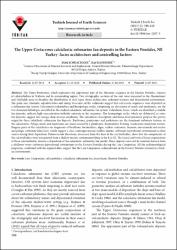| dc.contributor.author | Sofracıoğlu, Dilek | |
| dc.contributor.author | Kandemir, Raif | |
| dc.date.accessioned | 2020-12-19T20:44:27Z | |
| dc.date.available | 2020-12-19T20:44:27Z | |
| dc.date.issued | 2013 | |
| dc.identifier.citation | Sofracıoğlu, D., Kandemir, R. (2013). The Upper cretaceous calciclastic submarine fan deposits in the Eastern Pontides, NE Turkey: facies architecture and controlling factors. Turkish Journal of Earth Sciences, 22(4), 588-610. | |
| dc.identifier.issn | 1300-0985 | |
| dc.identifier.issn | 1303-619X | |
| dc.identifier.uri | https://app.trdizin.gov.tr/makale/TVRRMk16TXdNQT09 | |
| dc.identifier.uri | https://hdl.handle.net/11436/5995 | |
| dc.description.abstract | The Tonya Formation, which represents the uppermost part of the Mesozoic sequence in the Eastern Pontides, consists of calciturbidites in Trabzon and its surrounding region. Two stratigraphic sections of the unit were measured in the Hacımehmet and Gürbulak areas to decipher the distribution of rock types, facies architecture, sediment textures and depositional environment. The grain size, channels, suprafan lobes and slump structures of the sediments suggest that calciclastic sequences were deposited in a submarine fan system. Calcarenites/calcirudites and hemipelagic rocks, comprising an alternation of marls and mudstones, are the two dominant lithologies described in the studied calciclastic submarine fan system. Calciclastic facies, which are identified as middle fan deposits, indicate high-concentration turbidity currents in the sequences. The hemipelagic rocks, which are delineated as outer fan deposits, suggest low-energy, deep-marine conditions. The microfacies description and fauna determinations propose the gravity origin for these calciclastic submarine fan deposits. Rudstones, grainstones and packstones are the dominant carbonate textures in the calcarenites. Pelagic marls and mudstones are characterised by a planktonic, foraminifera-bearing, wackestone-mudstone texture. Biogene parts of the calciclastics are fragments of benthonic foraminifers, algae, rudists, echinoids, bryozoa, inoceramids and neritic and pelagic carbonate lithoclasts, which suggest a close contemporaneous shallow marine carbonate depositional environment as their source during their deposition. Palaeocurrent directions, measured from the base of the calciturbidites, show that the components of the calciturbidites were transported from a shallow marine environment lying to the E or SE. The lateral and vertical facies organisation of these calciturbidites favours a deposition of the calciclastic submarine fan model. These deposits were fed by material derived from a shallower water carbonate depositional environment in the Eastern Pontides during the Late Campanian. All the sedimentological properties, combined with the regional data, suggest that the Late Campanian sedimentation in the Eastern Pontides formed in a backarc environment. | en_US |
| dc.language.iso | eng | en_US |
| dc.rights | info:eu-repo/semantics/openAccess | en_US |
| dc.subject | Jeoloji | en_US |
| dc.subject | Geç Kampaniyen | en_US |
| dc.subject | Kalsitürbiditler | en_US |
| dc.subject | Kalkiklastik Denizaltı Fanı | en_US |
| dc.subject | Mikro Yüzler | en_US |
| dc.subject | Doğu Pontidler | en_US |
| dc.subject | Karbonat Platformu | en_US |
| dc.subject | Kompozisyonel Değişiklikler | en_US |
| dc.subject | Volkanik Kayalar | en_US |
| dc.subject | Evrim | en_US |
| dc.subject | Kuzey | en_US |
| dc.subject | Magmatizma | en_US |
| dc.title | The Upper cretaceous calciclastic submarine fan deposits in the Eastern Pontides, NE Turkey: facies architecture and controlling factors | en_US |
| dc.type | article | en_US |
| dc.contributor.department | RTEÜ, Mühendislik ve Mimarlık Fakültesi, Jeoloji Mühendisliği Bölümü | en_US |
| dc.contributor.institutionauthor | Kandemir, Raif | |
| dc.identifier.volume | 22 | en_US |
| dc.identifier.issue | 4 | en_US |
| dc.identifier.startpage | 588 | en_US |
| dc.identifier.endpage | 610 | en_US |
| dc.ri.edit | oa | en_US |
| dc.relation.journal | Turkish Journal of Earth Sciences | en_US |
| dc.relation.publicationcategory | Makale - Uluslararası Hakemli Dergi - Kurum Öğretim Elemanı | en_US |


















